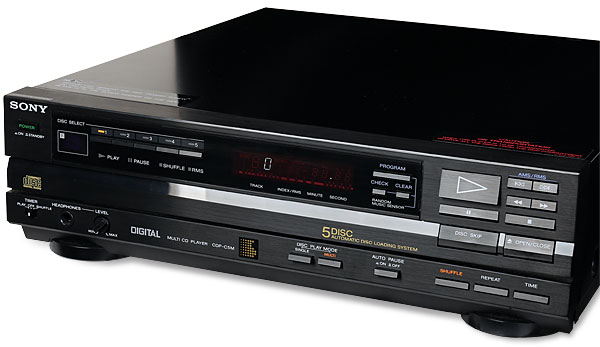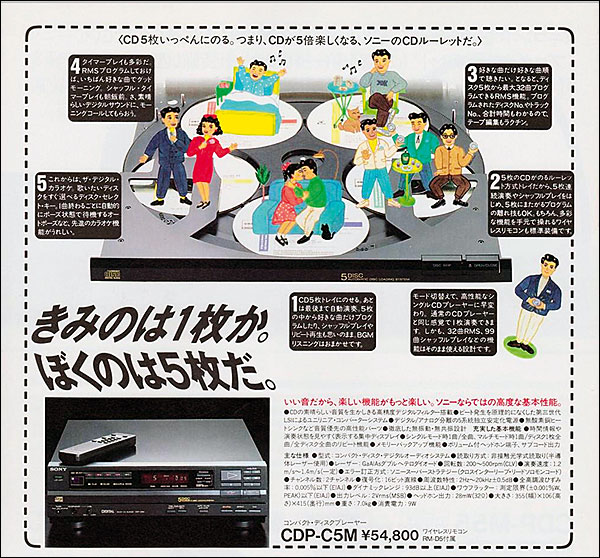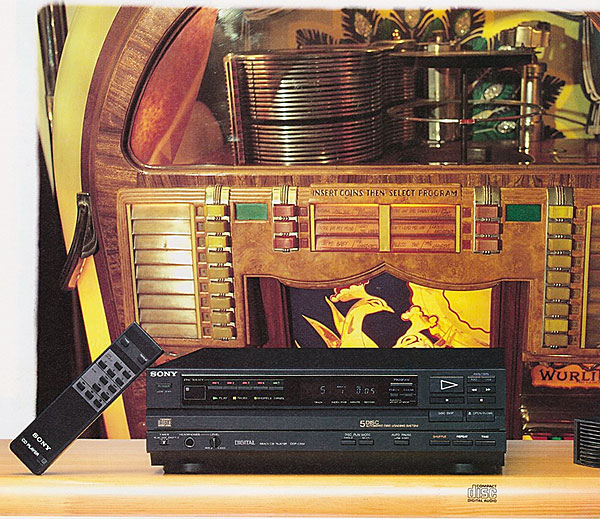Sony CDP-C5M CD player Page 2
![]() Tim Listens
Tim Listens
The Sony CDP-C5M certainly shows how the sound quality available from the company's mainstream CD player range improved since it launched the CDP-101 [HFN Jan '12] in 1982. This has been detailed in HFN via the Sony-designed Ferguson CD 01 and CD 03 models [HFN Jan '19 & Sep '19]. The use of a digital filter elevates the CDP-C5M further still, although to my mind it still does not reach the gold standard set by Philips at the time.
The CDP-C5M also shows that the belief there is a specific sound quality penalty to pay in return for multi-play convenience is simply not true. Indeed, one would have to have entered an elevated and fairly exotic realm of the Sony range at the time to usefully better it for audio performance.
As well as determining the key sonic signature of the Sony machine, I was also keen to figure out what one might use such a player for. I confess to having found it a challenge to settle on which of my discs were my favourite five, and who knows what one would be wanting to hear in three hours' time? Classical and opera buffs may appreciate an almost uninterrupted performance, but around six hours of anything non-stop is bound to get fatiguing.

The rather limited random play option only compounds the problem, but I did find one collection of discs that suited my needs perfectly. Now 100 Hits Forgotten 80s [Sony CDNNNOW82], issued by Sony music oddly enough, is a 5CD set sufficiently varied for the purposes of reviewing yet which the player could chomp through while continuing to engage my interest musically. So there it is, pile in the compilation discs of your choice and just let the machine get on with it.
The rather hard and sterile nature of many early Sony players is still in evidence here to some extent. What has improved is the overall structure of the sound, the at times diffuse imaging of previous models no longer a major issue with this iteration of the design – even if it is not completely resolved. Bass showed an incremental improvement too, being smoother and richer-sounding. Yes, the presentation the CDP-C5M low down is still not indulgent in the manner of the classic Philips machines, but I did feel that the compromise on offer is a workable one and makes for an enjoyable listen.
Gold Rush
What one gains in return for an overall sound that can be a bit dry and matter of fact is an excellent sense of focus, notes and sounds seeming to start and stop in sharp relief. Hearing the CDP-C5M unravel The Stone Roses' 'Fool's Gold' [Silvertone ORECD 535] was impressive. Often this track can sound like it's being heard from somewhere down a corridor, but with the CDP-C5M you are at least in the same room. That instantly recognisable bassline chunks away pleasingly too. This isn't a classic heavyweight player in the style of the Technics SL-P1200 [HFN Apr '13] or the Philips CD960 [HFN Jul '20] but it certainly comes far closer than its appearance may suggest. The only real issue is the player's slightly brittle, splashy treble which, to an extent, is always present. This isn't a corollary of the design's basic topology. After all, Aiwa's DX-1500 with its 16-bit/2x DAC is in many ways a less developed version of the same idea and yet it still sounds smooth and refined.

Percussion and female vocals bring this effect to the fore. Tracks such as 'Walking In The Rain' by Grace Jones [Island IMCD 17] sound a little synthetic and overproduced when played on this machine. This is not to dismiss Sony's first UK market multi-CD player as an irrelevance to the vintage hi-fi enthusiast. It performs as well as, if not better than, many of its rivals of the era. It has proved to be durable too, so the chances of finding one that still works properly are favourable.
Buying Secondhand
One flaw inherent in the design of the CDP-C5M is that if the machine is tipped up or carried while there are discs in the carousel they fall out and jam up the mechanism. This is by far the most common fault encountered with this model. Other than this, the disc-handling system is robust, the only weak point being the belts linking the motors to the rest of the gearing. If these stretch or wear the mechanics can lock in a position where further dismantling becomes difficult, making for a potentially time-consuming repair.

This aside, this carousel player is far less problematic to own than a cartridge-type player of the same generation. For anything other than the simplest of service inspections it is necessary to unravel some of the internal wiring. Afterwards, this must be dressed back in exactly the original pattern to avoid it becoming caught up in the works. The laser, meanwhile, is a KSS-150A, which is a type that can be cheaply replaced if faulty. Be aware, though, that the quality of those available today can be variable so you may have to try several before you find one that works.
Poor soldering is the most common problem on the main PCB, as is the use of blobs of glue to support some of the components. This can become conductive and corrosive with age, in extreme cases dissolving the component legs and copper track-work.
Hi-Fi News Verdict
You will find that the fragile mechanisms of multi-CD players often disintegrate after a few short years, so to find a durable example of the breed functioning after three decades of use is a testament to the care taken in the design and manufacture of the CDP-C5M. While its chip technology was soon outclassed it's nonetheless a well ordered machine, and a good player to listen to. Why not give it a try?


















































